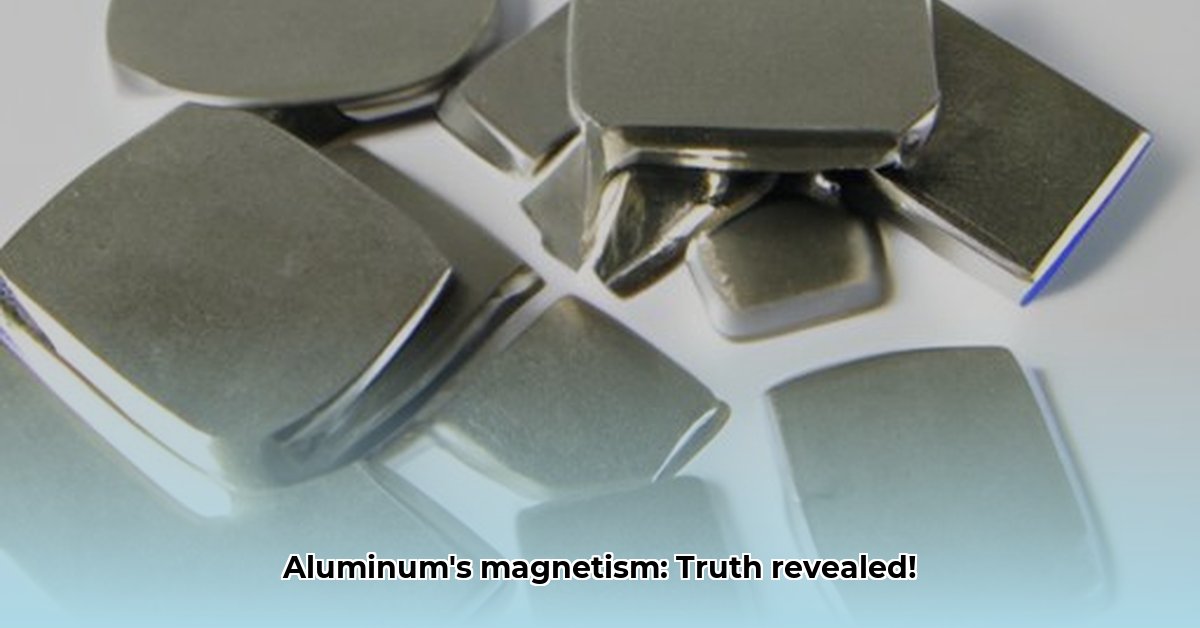Aluminum’s relationship with magnetism is more nuanced than a simple “yes” or “no.” While it’s not magnetic in the way we typically think – like iron sticking to a fridge magnet – aluminum does interact with magnetic fields, just very subtly. This article delves into the science behind this interaction, exploring paramagnetism, alloys, and the surprising ways aluminum’s weak magnetism plays a role in everyday technology.
The Subtle Dance of Aluminum and Magnets
No, aluminum is not considered magnetic in the traditional sense. You won’t see aluminum cans clinging to your refrigerator or foil spontaneously wrapping itself around magnets. But this doesn’t mean aluminum is entirely immune to magnetic fields. The truth lies in a phenomenon known as paramagnetism.
Defining the Magnetic Spectrum
Before diving into paramagnetism, let’s clarify some key terms:
- Magnetism: A fundamental force involving the attraction and repulsion of certain materials, often mediated by magnetic fields.
- Ferromagnetism: The strongest type of magnetism, exhibited by materials like iron, nickel, and cobalt. Ferromagnetic materials are strongly attracted to magnets and can become magnetized themselves.
- Paramagnetism: A weak form of magnetism where materials are slightly attracted to magnetic fields. This attraction is much weaker than ferromagnetism and disappears when the external magnetic field is removed.
- Diamagnetism: The opposite of paramagnetism; diamagnetic materials are weakly repelled by magnetic fields.
Aluminum’s Paramagnetic Nature
Aluminum falls into the paramagnetic category. Imagine trying to nudge a heavy shopping cart – it takes effort, and the movement is subtle. Similarly, aluminum experiences a very slight attraction to magnets, so slight that you’d likely need specialized equipment to detect it.
This weak attraction is due to the arrangement of electrons within aluminum atoms. Specifically, unpaired electrons in aluminum’s outer shell try to align with an external magnetic field, resulting in a weak pull. However, this alignment is temporary and easily disrupted, so aluminum doesn’t retain any magnetism once the external field is removed.
The Alloy Exception: When Aluminum Becomes Magnetic
The magnetic behavior of aluminum can dramatically change when it’s mixed with other metals to form alloys. Adding ferromagnetic elements like iron or nickel to aluminum can create an alloy that is strongly attracted to magnets. This occurs because the added elements influence the electron arrangement within the alloy, promoting a stronger alignment with external magnetic fields.
The strength of the magnetism in an aluminum alloy depends on the type and quantity of the added metal. For example, an alloy with a small percentage of nickel might be weakly magnetic, suitable for sensors, while a higher nickel content could create a stronger magnet used in aerospace components. It’s important to distinguish this alloy-induced magnetism from the inherent paramagnetism of pure aluminum.
Addressing Common Questions: FAQs
- Can I pick up aluminum cans with a magnet? No, the paramagnetism of pure aluminum is far too weak for a typical magnet to lift an aluminum can.
- Is aluminum safe to use around MRI machines? Yes, aluminum’s lack of ferromagnetism makes it safe for use in MRI environments. It won’t be significantly affected by the powerful magnetic fields or interfere with the imaging process.
- Why does some aluminum seem magnetic? Sometimes, iron contamination during manufacturing can give aluminum a slightly magnetic appearance. However, this is due to the iron particles, not the aluminum itself. A strong neodymium magnet can help differentiate between true alloy magnetism and surface contamination.
Practical Applications: Aluminum’s Weak Magnetism at Work
Although seemingly insignificant, aluminum’s weak magnetism plays a crucial role in several applications:
- Eddy Current Braking: Aluminum’s paramagnetism is essential for eddy current braking systems used in high-speed trains, roller coasters, and some gym equipment. As a magnet moves past aluminum, it induces small electric currents (eddy currents) within the metal. These currents, in turn, create their own magnetic fields that oppose the motion of the original magnet, generating a braking force.
- Magnetic Shielding: Aluminum’s ability to weakly interact with magnetic fields also makes it an effective shield for sensitive electronics. It acts as a barrier, diverting magnetic fields away from components that could be disrupted by magnetic interference. This is why aluminum enclosures are often used in devices like hard drives and medical equipment.
- Aerospace Applications: Aluminum’s low density (light weight) and weak magnetic susceptibility make it ideal for aircraft construction. It minimizes magnetic interference with sensitive onboard instruments while keeping the overall weight of the aircraft down.
Ongoing Research and the Future of Aluminum Magnetism
The field of materials science is constantly evolving, and our understanding of magnetism continues to grow. Researchers are actively exploring new aluminum alloys and their magnetic properties, particularly at very low temperatures, with potential applications in areas like superconducting magnets and quantum computing. While we currently understand the basics of aluminum’s interaction with magnetic fields, ongoing research suggests there may be further complexities and possibilities yet to be discovered.
| Material Type | Magnetic Behavior | Examples |
|---|---|---|
| Ferromagnetic | Strong attraction | Iron, Nickel, Cobalt |
| Paramagnetic | Weak attraction | Aluminum, Platinum, Oxygen |
| Diamagnetic | Weak repulsion | Copper, Bismuth, Gold |
So, while aluminum might not be a magnetic superstar, its subtle interaction with magnetic fields makes it a surprisingly versatile material. From bringing high-speed trains to a halt to protecting sensitive electronics, aluminum’s quiet paramagnetism plays a vital role in our technological world.
- Wind Energy For Residential: Is It Right For Your Home? - November 28, 2025
- Wind Energy Flyer: Design a Powerful Green Campaign Show - November 26, 2025
- What Types Of Jobs Does Wind Energy Create? - November 23, 2025
















